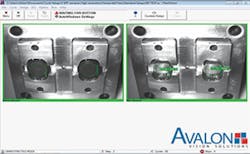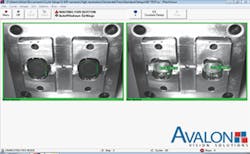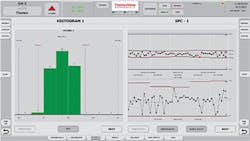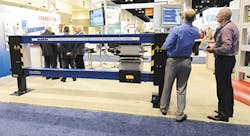To err is human; to catch a mistake in process — that's innovation.
Flagging errors before they become disasters is the goal of process-monitoring technologies throughout the plastics industry. Companies that cater to injection molders, extruders and blow molders showed off their wares at NPE2018, offering the promise of catching mistakes in real time, so they can be fixed with minimal headaches. Employing the latest in software and hardware, including cameras, the new and updated mold-temperature watchers and web and pipe gauges give operators the opportunity to see, analyze and address production problems.
INJECTION MOLDING
Avalon Vision Solutions showed off an innovation for injection molders that is available as an add-on to its MoldWatcher and QualityStation products. Ed Kachnic, the company's CEO and president, demonstrated ThermalWatch with a simple wave of his hand.
The new system features a thermal camera that sits above an injection molding machine and monitors mold temperature. When Kachnic passed his hand in front of the tiny, simulated mold at the Avalon booth, his hands stood out — too cold for processing.
Users can opt for either a Euromap 12 or Euromap 67 machine I/O interface. The system, which has a touch-screen interface, allows operators to set maximum and minimum temperatures for individual sections of the mold. They can also specify how the machine responds if temperatures fall outside those parameters; to limit waste, such actions can include a complete machine shutdown.
ThermalWatch complements Avalon's other products. MoldWatcher is a vision system that inspects parts within the mold and ensures that they are in the moving half of the mold before authorizing ejection; it also verifies that ejection takes place appropriately before allowing the mold to close for the next cycle. It works on horizontal and vertical shuttle and rotary injection molding machines. The multi-camera QualityStation system can be used either manually or in conjunction with materials-handling equipment to inspect parts.
Like Avalon's other products, Kachnic said ThermalWatch was designed with simplicity in mind.
"We make our systems so shop-floor people can use them," he said.
FILM AND SHEET EXTRUSION
Innovations from six exhibitors offer improved process monitoring of film and sheet operations.
At its NPE booth in Orlando, Fla., Thermo Fisher showed why boring can be better.
Product manager Chuck Blanchette emphasized the mundane as he touted the upgrades to the company's film- and sheet-testing platform, known as the 21Plus! Now available as 21PlusHD, the measurement and control system, which can be specified with scanners and sensors, sports an HMI that wouldn't interest you — unless something has gone wrong.
"You want a problem to jump out at you," he said, "but everything else should be boring." That means no extra-bright colors, no animations, no flashing — unless there's an issue.
What the new HMI does offer, however, is data. Blanchette said it's been designed to show trends and information in context, to make it easier to use. With the information, operators can be proactive, he said.
"It's basically making sure your HMI is operator-centric. It's designed to be clear and intuitive," he said. To minimize the need for training, displays are customizable.
In addition to rolling out the 21PlusHD, Thermo Fisher has updated it terahertz sensors, which can be used as part of the film- and sheet-measurement platform. One of the units can be used to measure down to 10 microns, with a maximum sensing size of 10 centimeters. Blanchette said the non-nuclear, non-contact sensor is unique in that it can provide measurements of thickness, basis weight and density. It works with many plastics, including opaque materials, and a multitude of layers.
"I think we've done about 10 or 11 layers in our tech lab," he said.
Mahlo, which makes traversing scanners and measurement scanners for film and sheet, showcased several innovations that can be used as part of its QMS-12 platform. When specified as part of the complete web-gauging platform, the sensors and scanners are provided along with a control and display station.
Mahlo's newest O-frame scanner, the WebPro-XS-II, has a maximum web width of about 6.5 feet. Taking up just 10 inches in the machine direction, the scanner can support a wide variety of sensors to measure basis weight, thickness, density and moisture in films, sheet, nonwovens and coatings, with thicknesses ranging from 0.2 micron to 1 inch. The product continuously passes between scanners and through the frame, which spans the width of the web.
"It is a much more compact version of what has been available, yet it still has all the features of our larger web scanners," said Eric Reber, technical sales manager for Mahlo's web process solutions unit.
Featuring software and sensors Reber described as very accurate, the robust and well-sealed scanner is a "tank." Because of its compact size, it's especially suited for manufacturers that are tasked with finding space for scanning technologies for the first time.
Along with the WebPro-XS-II, Reber also touted Mahlo's new IMF-15 near-infrared sensor, which the company installed in a U.S. plant for the first time earlier this year, and the OptoScope WLI, a non-marking, white-light sensor that measures thin, transparent films and coatings.
The IMF-15 is a solid-state, non-nuclear sensor that measures moisture in web products, as well as the basis weight and thickness of films, sheet, nonwovens and coatings. According to Reber, it's especially appropriate for thin films, such as biaxially oriented PP.
Because the sensor has no moving parts, it is reliable and robust, he said. With software, it can map thickness fluctuations back to an individual die bolt.
"What we're able to do is scan back and forth across the sheet faster in much higher resolution and see much smaller changes in thickness," he said.
According to Reber, the OptoScope WLI provides quick, accurate measurements of monolayer film and other materials, such as silicone release coatings. It can measure thicknesses of layers and films down to 0.2 micron, with a repeatability of 0.01 micron.
"No one's been able to measure that thin before," he said.
In-line measurement technology maker Scantech also has refined its O-frame, with the debut this year of the third iteration of its Ultra Light for film and sheet.
Known as the UL03 — the Ultra Light O-Frame — the non-contact X-ray scanner is designed for tight spots. It's compact and lightweight, perfect for high frames or low ceilings. An auto-profile-control system, the scanner can communicate with the die bolts to make automatic adjustments to keep the product within appropriate specifications. Users have the option of printing out reports with each roll to show to their customers.
A Line Manager option allows Scantech to provide supervisory data for multiple scanners or multiple production lines.
The O-frames are available in increments of about 1.5 feet wide, up to about 11.5 feet.
Scantech Americas President Carlos Estévez touted the company's experience in the field.
"X-ray has been around for [many years]," he said. "We were the first to do it for plastics."
Honeywell has also recently updated its film- and sheet-scanning technology, with the installation of its largest ZipLine scanning measuring device yet. At 26-plus feet, the device is about twice as wide as the original, which debuted at NPE2015. Jim Molnar, strategic marketing manager for the company's continuous web solutions unit, said the self-contained scanner has a cleaner design than traditional O-frame web scanners. Honeywell's version travels on tensioned steel cables and has no drive belts, carriage wheels, linear bearings or power tracks.
It can scan about 15.7 inches a second, though Molnar said users most often configure it for between 50 percent and 75 percent of its maximum speed. In general, it's appropriate for products with thicknesses of between about 10 microns and up to 7mm.
"Where it really shines is in cost and effort to maintain because there are so many fewer components," Molnar said.
To reduce space requirements, the ZipLine can be mounted directly to a machine frame.
PIPE AND TUBING EXTRUSION
NDC Technologies has made upgrades to its UltraScan pipe- and tube-measuring technology to provide more accurate measurements and open up Industry-4.0 possibilities.
Designed to measure wall thickness and concentricity as pipe passes through a water bath, the newest version of the system, called the Beta LaserMike UltraScan DSP Pro, now can handle more layers, said Jay Luis, global marketing communications manager for NDC.
"In the marketplace, this is the only one that can measure up to four layers," Luis said. "I don't think there's any that have any more than that."
The scanning system can be outfitted with between four and eight transducers. "This enables UltraScan Pro to fully evaluate the product at all critical locations for fast, accurate measurement of wall thickness and concentricity," Luis said.
Employing NDC's patented Snap technology, the LaserMike UltraScan DSP Pro locates the product and begins taking measurements immediately, with only a simple size calibration. It takes 10,000 wall measurements a second and provides 360-degree coverage.
"This gives plastic pipe and tube manufacturers the ability to immediately make process adjustments to avoid scrap and ensure quality results," Luis said. The technology tracks tolerances to catch wall variations, and takes average wall and concentricity measurements.
Depending on the model and frequency, the scanners can measure outer pipe diameters ranging from 7.5mm to 660mm, with wall thicknesses as thin as 0.254mm, and outer tube diameters ranging from 0.25mm to 63mm, with wall thicknesses as thin as 0.025mm.
The scanning systems feature new Wi-Fi capabilities and are equipped with a variety of protocols to allow intermachine communications.
With the upgrades, Luis said, "You can pull data and disseminate it from anywhere."
Karen Hanna, copy editor
Contact:
Avalon Vision Solutions LLC,
Lithia Springs, Ga., 770-944-8445,www.avalonvisionsolutions.com
Honeywell Process Solutions,Houston, 832-252-3500,www.honeywellprocess.com/en-US/
Mahlo America Inc.,
Spartanburg, S.C., 864-576-6288,www.mahloamerica.com
NDC Technologies Inc., Dayton, Ohio, 937-233-9935, www.ndc.com
Scantech Americas Inc.,
Gaithersburg, Md., 301-990-9201,www.scantech.com
Thermo Fisher Scientific Inc.,
Waltham, Mass., 781-622-1000,www.thermofisher.com
About the Author
Karen Hanna
Senior Staff Reporter
Senior Staff Reporter Karen Hanna covers injection molding, molds and tooling, processors, workforce and other topics, and writes features including In Other Words and Problem Solved for Plastics Machinery & Manufacturing, Plastics Recycling and The Journal of Blow Molding. She has more than 15 years of experience in daily and magazine journalism.




